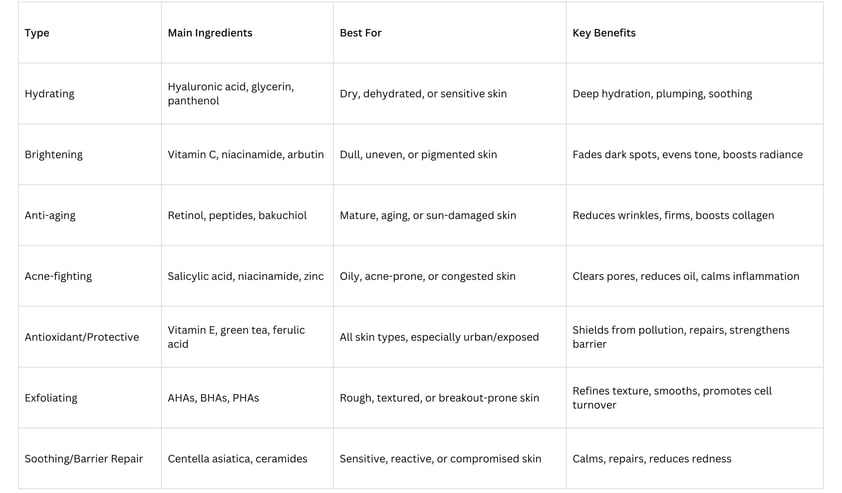The Power of Serums: Targeted Solutions for Every Skin Concern
Serums have become a powerhouse step in modern skincare routines, offering targeted solutions for a wide range of skin concerns. Here’s a comprehensive guide to what serums are, why they’re used, how they differ from moisturizers, the main types available, and how to use them for the best results.
What Is a Serum and What Does It Do?
A facial serum is a lightweight, fast-absorbing skincare product formulated with a high concentration of active ingredients. Unlike moisturizers, which are thicker and designed to lock in hydration by forming a barrier on the skin’s surface, serums are thinner and designed to penetrate deeper into the skin. This allows them to deliver potent actives like antioxidants, vitamins, peptides, and acids directly into the skin’s deeper layers, making them especially effective for targeting specific concerns such as dryness, pigmentation, fine lines, or acne.
Key characteristics of serums:
Higher concentration of active ingredients than most other skincare products.
Lightweight, often water-based or gel-like texture for quick absorption.
Designed to address specific concerns, from hydration to anti-aging to brightening.
Why Use a Serum?
Serums are used to efficiently deliver beneficial ingredients where they’re needed most. Because of their small molecular size and potent formulas, they can:
Hydrate and plump the skin (with ingredients like hyaluronic acid or glycerin).
Brighten and even out skin tone (with vitamin C, niacinamide, arbutin).
Fight signs of aging (with retinol, peptides, bakuchiol).
Calm and repair (with centella asiatica, ceramides, panthenol).
Control acne and oil (with salicylic acid, niacinamide, zinc).
Defend against environmental damage (with antioxidants like vitamin E, green tea, ferulic acid).
Types of Serums and Their Main Benefits
How to Use a Serum for Maximum Benefit
Cleanse: Always start with a clean face to ensure optimal absorption.
Apply on Damp Skin: After cleansing and (optionally) toner, apply serum to slightly damp skin for better penetration.
Use a Small Amount: 2–3 drops or a pea-sized amount is usually enough for the whole face.
Pat or Gently Massage: Use fingertips to pat or lightly massage the serum into the skin.
Layer Correctly: Apply serums before heavier creams or oils. If using multiple serums, layer from thinnest to thickest consistency, and avoid combining actives that may irritate (e.g., vitamin C and retinol together).
Seal with Moisturizer: Follow with a moisturizer to lock in the serum’s benefits and hydrate the skin.
Serum vs. Moisturizer: What’s the Difference
Serum: Lightweight, high concentration of actives, penetrates deeply, targets specific concerns.
Moisturizer: Thicker, forms a barrier, locks in hydration, protects from environmental stressors.
Can serums replace moisturizers? Usually not—serums treat, moisturizers seal and protect.
Choosing the Right Serum
Select a serum based on your primary skin concern:
Dryness: Hydrating serum with hyaluronic acid or glycerin.
Pigmentation: Brightening serum with vitamin C or niacinamide.
Aging: Anti-aging serum with retinol or peptides.
Acne: Acne-fighting serum with salicylic acid or niacinamide.
Redness/Sensitivity: Soothing serum with centella or ceramides.
Serums are a potent, customizable step in your skincare routine, delivering concentrated actives deep into the skin for targeted results. Whether your goal is hydration, brightening, anti-aging, or acne control, there’s a serum for you. Apply after cleansing (and toner, if used), before moisturizer, and enjoy visible improvements in your skin’s health and appearance.




